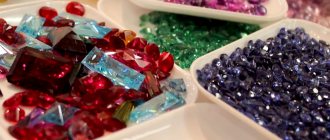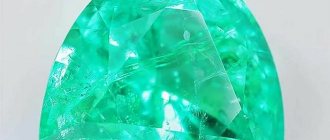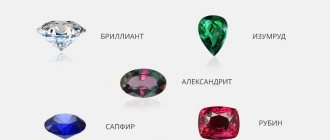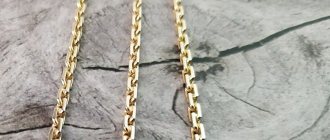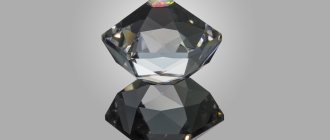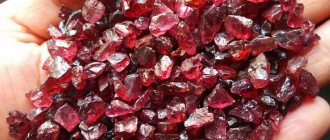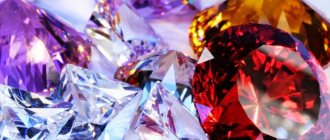Synthetic gemstones
This group includes complete analogues of natural stones. They have a similar crystal lattice, since their cultivation imitates the natural process of stone formation. The only difference is that in the laboratory and in industrial settings the stones are grown in a few days or weeks. Initially, crystal synthesis technologies were expensive, but today synthetic gemstones are cheaper than their natural counterparts. At the same time, they can have maximum purity and color saturation, which is rarely found in nature. Stones in this group receive the names of natural minerals with the addition of “synthetic” or “grown”: “synthetic ruby”, “grown emerald”.
Artificial imitators
Synthetic spinel
Synthetic spinel is often used as a simulant because it can mimic the appearance of many natural stones (such as sapphire, zircon, aquamarine and peridot), depending on its color. Its accurate reproduction of the colors of other stones makes it a common choice for simulating zodiac stones.
A group of boules of synthetic spinels and faceted stones illustrates how these materials are made to look like ruby and sapphire.
Synthetic rutile
Synthetic rutile was produced in the late 1940s and was used as an early diamond simulant. It is made using the flame crystallization method. The result is an almost colorless stone with a slight yellowish tint, but it can be made into various colors by doping with coloring ions.
Natural diamond (left), as well as various diamond simulants: (from left to right) synthetic rutile, gallium gadolinium garnet (or GGG), synthetic spinel, strontium titanate, synthetic corundum, yttrium aluminum garnet (or YAG), and colorless zircon.
Strontium titanate
This colorless man-made material became a popular diamond simulant in the 1950s. However, its dispersion (the optical property that creates fire in a faceted gemstone) is more than four times that of diamond. Strontium titanate is most often produced by flame crystallization and can be made into a variety of colors, such as dark red and brown, by adding certain chemicals during the growth process.
Yttrium aluminum and gallium gadolinium garnets
YAG and GGG are man-made materials that have been used as diamond simulants for many years. In 1960, yttrium aluminum garnet (YAG) and its “cousin” gallium gadolin garnet (GGG) joined the ranks of classic diamond simulants such as glass, natural zircon, and colorless synthetic spinel. YAG and GGG are also available in a variety of colors.
Yttrium aluminum garnets (or YAG) can be produced in a variety of colors, as shown in this image. In the middle: a colorless uncut simulant crystal.
Synthetic cubic zirconia (CZ)
Colorless synthetic cubic zirconia (CZ) has almost completely replaced other diamond simulants over the past three decades. It is produced through a process called skull smelting. CZ can be made in almost any color, including dark tones, and thus imitate purple, green and even black gemstones.
Zircon (or CZ) made in a variety of colors, although colorless CZ is the most convincing diamond simulant.
Synthetic moissanite
Synthetic moissanite was developed in late 1990 as a diamond simulant. It is more similar to a diamond than all previous analogues. However, since natural moissanite is not found on Earth and can only be extracted from meteorites, it is a very valuable stone in itself. And synthetic moissanite most often imitates itself.
Natural diamond (left) and (left to right) lab-grown moissanites, colorless and greenish.
Glass
Glass is probably the most ancient simulator of precious stones. It can be made in any color, making glass a very popular substitute for many gemstones. Glass is used to imitate stones such as amethyst, aquamarine, and peridot. It can even be used to imitate special stones such as tiger's eye and opal, and by merging layers of glass, one can imitate agate, malachite or tortoise shell.
Glass can be made to resemble various gemstones, pictured here: a convincing substitute for malachite (left), and rutile quartz (right).
Glass, known as
"Slocum stone"
, can imitate the appearance of opal.
Plastic
Plastic is often used to imitate precious stones in inexpensive jewelry. However, this modern artificial material can convincingly look like natural organic stones such as amber, pearls, corals, as well as aggregate stones: jade, turquoise and lapis. Plastic is a short-lived and fragile imitation, it is easy to damage.
Tempered Quartz
Tempered quartz is natural, colorless quartz that has been subjected to thermal shock and rapid cooling. The colorless material is first heated and then quenched in a cold liquid, such as water. Sudden cooling and, as a result, instant shrinkage, leads to the formation of many cracks across the entire surface of the stone. The stone is then immersed in a dye solution and the cracks are filled with the colored liquid. This makes quartz a convincing imitation of natural gemstones such as emerald, ruby and sapphire, although such stones can quickly be exposed by looking under a microscope.
Tempered quartz imitates emeralds and rubies.
Ceramics
The term "ceramics" is applied to all non-metallic materials produced by firing at high temperatures. The ceramic process produces imitations of two popular jewelry stones: lapis lazuli and turquoise. The finely ground powder is heated, sometimes under pressure, to produce a solid material with a fine-grained structure upon recrystallization.
Imitation turquoise
The cool blues and greens of turquoise have captivated people for centuries. More than 5,000 years ago, Egyptian pharaohs decorated themselves with turquoise. The familiar stone is a microcrystalline aggregate whose attractiveness comes from inclusions of veins of rock called matrix. In the early 1970s, the Gilson Company showed imitation turquoise as well as imitation lapis.
Gilson's imitation turquoise and lapis lazuli look like convincing substitutes for natural stones.
Imitation lapis lazuli
Deep blue lapis, a treasure of ancient civilizations, was mined in Afghanistan more than 6,000 years ago. The stone is a combination of several different minerals. Sometimes it contains golden flecks of pyrite, making it even more attractive. Gilson's Lapis should be considered an imitation because it has some ingredients and physical properties that are different from natural Lapis.
How do grown stones differ from natural ones?
Often we are faced with the need to make an initial assessment of jewelry products.
You walked into a store or approached a stand at a jewelry exhibition. There are many stones or decorations before your eyes. How to form a first opinion about the seller and what exactly should be avoided in such situations? When assessing stones by eye, it is very important to pay attention to:
- the totality of all shades of color,
- optical parameters,
- features of the “inner life” of a particular stone.
Such a detailed analysis requires significant experience in working with natural stones and their artificial analogues. But there are still some things within our power.
Well-known production centers
More than a hundred tons of artificial sapphires are produced annually in the world. Centers for the production of synthetic stones: Japan, China, USA, and Russia. It is in the Russian Federation that one of the largest enterprises for growing artificial sapphires in the world is located.
One of the largest enterprises specializing in the production of emerald analogues is Tairus. It was created by forces of Russia and Thailand. The specialists of this center managed to grow emeralds whose quality is in no way lower than the world-recognized Colombian gems. Emeralds are also grown in Japan and Belarus. Among European countries, Switzerland, Germany and France specialize in green stones.
Most artificial pearls are grown in China and Japan.
Natural minerals will always be in demand and will never fall in price. Especially considering that stocks are constantly decreasing. In many cases, they can be replaced by artificial analogues. Synthetic stone can be grown in any color, large size and with specified technical characteristics.
Should you always choose higher purity?
You may already know that clarity is one of the four elements that determine the quality of a diamond, but what about other gemstones? You of course want to make sure that their color is what you are looking for, but you should also look at the clarity and how?
Assessing the purity of a gemstone.
Like diamonds, other stones are also classified based on clarity. And the classification principle is the same: the fewer inclusions, the higher it is. However, they are not rated on a generally accepted scale.
Different jewelers use different methods, but the general concept of all these scales is the same.
You, as the client, should be concerned with how many inclusions the stone has and how visible they are, right?
In fact, with colored stones it is not so simple.
What to look for when purchasing?
The exact criteria for judging gems depends on their type, but there are some general tips that apply to everyone.
First, make sure you like the color and transparency. Keep in mind that the larger the stone, the more inclusions will be visible when worn.
After this, take a closer look at the stone to see any signs of damage on its surface or interior.
Make sure it is not broken as any chips will weaken its structure.
In addition, there should not be any cracks in it. Any damage to the structural integrity may cause the stone to break upon impact.
Synthesized stones: a little history
The first synthetic stone, a 10-carat ruby, was obtained in 1891 by the French mineralogist Auguste Verneuil. Using the Verneuil method, it became possible to grow crystals suitable for jewelry use, and in 1910, synthetic sapphire was obtained in a similar way. An artificial emerald, identical to natural, was first grown in 1935.
But with girls’ best friends – diamonds – not everything is so simple. In 1954, in the laboratory of the American company General Electric, the first artificial diamond “ripened”, whose growth cycle could be repeated on an industrial scale. But it was a mineral of technical significance, not jewelry. Nowadays, the world annually produces millions of carats of diamonds and diamond chips for the needs of manufacturers of various instruments, devices, and instruments.
Gem-quality man-made diamonds were introduced by Herbert Strong and Robert Wentorf (both of General Electric) in 1970, but analogues have failed to flood the jewelry market today. The process of growing king stones is long, complex and expensive compared to other laboratory-produced gems. A diamond cut from a synthetic crystal can cost from 50% to 90% of the price of a natural nugget of similar weight and processing, or even exceed its cost. According to scientists, this direction is the future, but for now there is no need to fear that real diamonds in jewelry will be replaced by grown ones.
